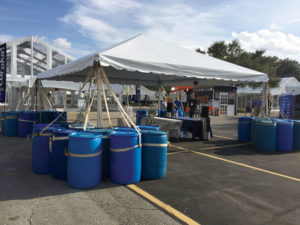
By Nick Deninno
Q: When I can’t stake, what do I need to understand about water barrels?
A: Historically, water barrels offered an economical solution for anchoring a tent. Unfortunately, the reality is that water is not always available, barrels are time consuming to fill and often cannot be emptied on-site. Tent professionals are trained to properly anchor before lifting a tent to combat potential wind. In the case of water barrels, this protocol is often neglected in an effort to save time, and the tent is installed prior to filling barrels, which are commonly not filled completely.
In recent years, tent professionals have engaged in an industry wide conversation about proper ballasting. More municipalities and venues are banning water barrels, and we expect this trend to spread.
Let’s talk about the scientific reason to abandon water barrels. A water barrel is tall, narrow and it ties off from the top. There is potential for slip, especially if tied too tight. A plastic barrel offers little resistance against concrete or asphalt surfaces and has a tendency to slide. These factors reduce a typical barrel’s 480 pounds of water weight to a barrel that can fail at as little as 200 pounds of force.
Q: What is a safer alternative to water barrels?
A: A widely accepted, safe and reliable alternative to water is cement ballast. Water weighs 61 pounds per cubic foot, while cement weighs about 148 pounds per cubic foot, which significantly reduces the ballast footprint. Cement blocks have a lower center of gravity and are less likely to tip while offering more resistance against sliding. The reduced footprint also presents an opportunity to properly ballast larger tents. For example, a 40-foot-wide tent will typically call for 2,000 to 4,000 pounds per leg, which is nearly impossible to accomplish with water barrels.
Q: How do I explain the additional costs to my customer?
A: Connecting with the customer to establish trust is the first step. The goal is to help them understand that electing to abandon water ballast is a responsible decision and in their best interest. If you are faced with a customer who needs more proof, the IFAI TRD ballasting study serves as a credible resource.
As a community of tent renters, we can all benefit from infusing safety and standardizing practices, in ballasting and elsewhere. It’s good for managing our own company risk and reputation as well as the reputation of the tenting industry.
By Nick Deninno, B&R Innovations LLC, Bethpage, N.Y.
 TEXTILES.ORG
TEXTILES.ORG


